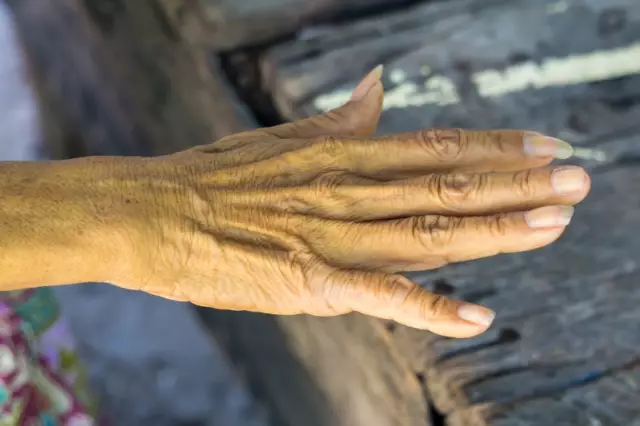- Author Rachel Wainwright [email protected].
- Public 2023-12-15 07:39.
- Last modified 2025-11-02 20:14.
Jaundice
Brief description of the disease
Jaundice is a consequence of diseases of the liver and other organs, manifested in the staining of the skin, mucous membranes and sclera in yellow due to deposits of bile pigment - bilirubin in them. In a normal state, this pigment is almost completely excreted outside along with the contents of the digestive system, but in sick people bilirubin accumulates in the body and indicates problems with the biliary tract, liver and other vital systems. In some cases, jaundice in children and adults is manifested as a result of an abnormally intense process of breakdown of red blood cells or after taking certain medications. I would like to immediately note that if a person is diagnosed with jaundice, treatment is based on establishing its cause and eliminating the underlying disease, and not the effect,which is a change in the color of the skin and mucous membranes.
Causes of jaundice
- benign and malignant tumors in the liver;
- hereditary anomalies of the biliary tract;
- postoperative complications;
- liver and gallbladder diseases;
- the activity of some parasitic microbes;
- the consequences of taking certain groups of drugs.
It doesn't matter what the reason for you are showing signs of jaundice. The main thing is that this pathology leads to disruption of all body systems. This is especially true for the liver and kidneys.
Jaundice - symptoms of the disease and clinical picture

In medical practice, it is customary to distinguish several types of jaundice. Accordingly, the course of the disease strongly depends on the form of the disease, the age of the patient and some other important factors.
Obstructive jaundice is a consequence of a violation of the normal outflow of bile and problems with the absorption of bilirubin. Its causes are: gallstone disease, tumors of the bile ducts, mechanical damage to the gallbladder. With this form, the skin acquires not a yellowish, but a greenish tint, the patient has pronounced itching of the skin, the feces, as a rule, are discolored.
Jaundice of newborns is provoked by a lack of an enzyme and manifests itself in the first days of a child's life. It is divided into two types. The first is characterized by a sharp increase in the content of bilirubin in the blood, staining of the skin, sclera and mucous membranes in a bright yellow color, as well as individual signs indicating damage to the central nervous system. Type II neonatal jaundice is a mild yellowing of the skin and responds well to treatment.
Hepatic (true) jaundice - manifests itself both under the influence of hereditary factors and after infectious or toxic damage to the liver. In particular, signs of jaundice occur with toxicosis, acute infectious diseases, and intoxication of the body. Itching is poorly expressed, the skin and mucous membranes are stained in saffron yellow, less often in a reddish color. The patient's urine becomes dark in color, the feces are discolored. In severe forms of the disease, liver failure develops.
Hemolytic jaundice is a consequence of increased hemolysis of erythrocytes, which, in turn, leads to an intense release of bilirubin. If a patient is diagnosed with hemolytic jaundice, the symptoms have all the signs of poisoning with snake venom, sulfonamides, arsenic hydrogen and other substances that affect the hemolysis of erythrocytes. Exacerbations of the disease occur with hypothermia and new intoxications. Children often have hemolytic jaundice of newborns, which develops due to Rh-conflict pregnancy.
Jaundice - treatment of the disease

The correct method of dealing with jaundice is based on the timely identification of the cause of the disease. For this, the patient is assigned a complete blood count and liver biopsy. Now in more detail about the main methods of treatment.
Phototherapy - successfully used for jaundice in newborns. The procedure involves placing the baby under a fluorescent lamp. As a rule, 1-2 days of therapy are enough, during which the liver has time to mature in order to independently process bilirubin. Phototherapy is ineffective for biliary atresia. In this case, surgical intervention is necessary.
Treatment of jaundice with medical methods is based on the intake of hepaprotectors, which include silibor, sirepar, silibinin and some other drugs. At the same time, the patient is prescribed antispasmodics - remidone, papaverine, no-shpu, dibazol.
If a patient has obstructive jaundice, treatment is impossible without surgical intervention, since drug therapy does not lead to the desired effect. The type of surgery depends on the cause of the improper flow of bile.
As you can see, there are actually quite a lot of methods for treating jaundice, so do not self-medicate and, at the first symptoms of the disease, contact the specialists of the district clinic, who will prescribe the necessary tests and choose the most adequate treatment.
YouTube video related to the article:
The information is generalized and provided for informational purposes only. At the first sign of illness, see your doctor. Self-medication is hazardous to health!






